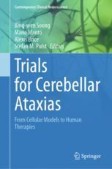Search
Search Results
-
Upbeat Nystagmus with an Unusual Velocity-Decreasing and Increasing Waveform: a Sign of Gaze-Holding Dysfunction in the Paramedian Tracts in the Medulla?
We report a patient with spontaneous upbeat nystagmus (UBN) due to an ischemic lesion involving the paramedian tract (PMT) in the medulla. Eye...

-

-
Effects of Baclofen on Central Paroxysmal Positional Downbeat Nystagmus
Paroxysmal positional nystagmus frequently occurs in lesions involving the cerebellum, and has been ascribed to disinhibition and enhanced canal...

-
Analysis of Fibroblast Growth Factor 14 (FGF14) structural variants reveals the genetic basis of the early onset nystagmus locus NYS4 and variable ataxia
Nystagmus (involuntary, rhythmical eye movements) can arise due to sensory eye defects, in association with neurological disorders or as an isolated...

-

-
The Use of Video-Head Impulse Test in Different Head Positions in Vertical Nystagmus and Ataxia Associated with Probable Thiamine Deficiency
Upward and downward bias of eye movement signals in the semicircular canals (SCC)- and/or otolith-related central pathways have been proposed to...

-
Gaze-holding and anti-GAD antibody: prototypic heterogeneous motor dysfunction in immune disease
The variability in motor dysfunction is not uncommon in autoimmune disorders. Antibody-mediated system-wide malfunction or effects on the neural...

-
Gravity-Independent Upbeat Nystagmus in Syndrome of Anti-GAD Antibodies
An autoimmune disorder of the central nervous system, stiff person syndrome, frequently presents with increased titers of 65KD anti-glutamic acid...

-
Role of Cerebellum in Gaze-Holding Disorders
Stability of the retinal image on the fovea is essential for clear vision. Our brain implements sophisticated neural mechanisms to ensure stable...
-
Ocular Motor Findings Aid in Differentiation of Spinocerebellar Ataxia Type 17 from Huntington’s Disease
Differentiation of spinocerebellar ataxia type 17 (SCA17) from Huntington’s disease (HD) is often challenging since they share the clinical features...

-
Scale for Ocular Motor Disorders in Ataxia (SODA): Procedures and Basic Understanding
The cerebellar disorders are evaluated with a number of clinical rating scales. None of these scales emphasize common ocular motor deficits. In...
-
Consensus Paper: Latent Autoimmune Cerebellar Ataxia (LACA)
Immune-mediated cerebellar ataxias (IMCAs) have diverse etiologies. Patients with IMCAs develop cerebellar symptoms, characterized mainly by gait...

-
Positional Downbeat Nystagmus
Positional downbeat nystagmus is one of the common forms of central positional nystagmus. It has been reported in various structural, metabolic, or...
-
Cerebellar Motor Disorders
Many of the clinical manifestations of cerebellar damage were described at the turn of the nineteenth and twentieth centuries by the pioneers of the...
-
Rhombomere 8 r8
As to rhombic lip derivatives, this chapter deals with the prepositus and subhypoglossal nuclei which together with the intercalated nucleus form the...
-
In Vivo Localization of the Human Velocity Storage Mechanism and Its Core Cerebellar Networks by Means of Galvanic-Vestibular Afternystagmus and fMRI
Humans are able to estimate head movements accurately despite the short half-life of information coming from our inner ear motion sensors. The...

-
Quantitative Oculomotor Assessment in Hereditary Ataxia: Systematic Review and Consensus by the Ataxia Global Initiative Working Group on Digital-motor Biomarkers
Oculomotor deficits are common in hereditary ataxia, but disproportionally neglected in clinical ataxia scales and as outcome measures for...

-
Clinical Features, Assessment, and Management of Patients with Developmental and Other Cerebellar Disorders
The cerebellum is essential for processing, modulating, and controlling movement, behavior, social, and cognitive functions. Cerebellar disorders...
-
A Review of Ocular Movement Abnormalities in Hereditary Cerebellar Ataxias
Cerebellar ataxias are a wide heterogeneous group of disorders that may present with fine motor deficits as well as gait and balance disturbances...

